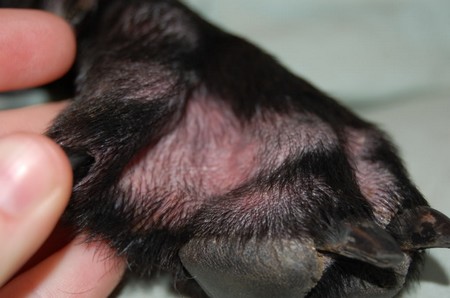Fungal infections are among the worst infections that dogs can get, since they are fatal. Some breeds of dogs are more prone to these infections, due to controlled breeding. Most often, the breeds that are most predisposed to get fungal infections are large breed, adult dogs. If you feel that your pet has a fungal infection, it is important to get it diagnosed and treated at the earliest. Prevention is, of course, better than cure. Fungal infections spread primarily due to animals frolicking in places where soil is enriched with bird droppings or organic manure. Therefore, it is best to keep your dog away from such places. If, however, your dog still gets infected, quick treatment will be most beneficial.
The symptoms of fungal disease in dogs will naturally vary depending on the exact microbe and whether is causes a systemic infection is stays limited to a certain part of the dog’s body. Gross lesions are commonly associated with fungal disease in dogs, but they are certainly not the only symptom. In order to provide a definite diagnosis, the vet can do a culture and hopefully determine which organism that is behind the problems experienced by your dog. Microscopic identification is also possible. In some cases, the obvious symptoms will be enough to determine the culprit and pick the right treatment. In other situations, a serology test is recommended.
Preventing fungal disease in dogs can be tricky, since fungi are found all over the world. Fungi even occur as a natural part of the microscopic flora living on our skin. There are however a few things that the dog owner can do. Since soil is the primary source of infection for a lot of fungal disease, you can keep your dog away from soil where dangerous fungi are known to occur. Fungi causing Blastomycosis in dogs are for instance known to occur in wet and sandy river banks. Keeping your dog away from bird’s nests and spots where a lot of birds defecate is also a good idea, since such places can contain a lot of infectious fungi, including Histoplasomosis. Bat faeces can also be contaminated and letting your dog run around inside bat caves is not recommended. In the south-western parts of the United States, the risk of catching Coccidioimycosis is especially high after stormy weather with a lot of rainfall.
Fungi can enter your dog in variety of different way, including being inhaled, being drunk from a contaminated puddle, or being ingested via contaminated food. Wounds can also become a point of entry for fungi.
Prevention is better than cure. So it is good to know the methods of preventing than to know how to treat. Keeping your pup clean and well-groomed helps reduce the risk of skin infections and other fungal issues, which makes regular visits to a dog grooming Greensboro specialist a smart part of your pet care routine.
